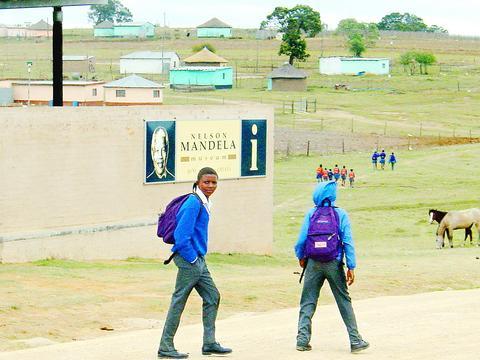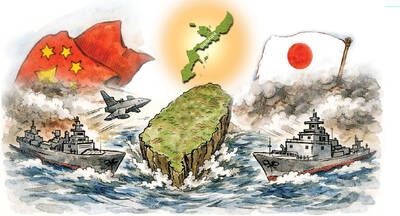Thousands of penguins on the rocky shores of Robben Island let the visitor for a moment forget that the island is a symbol of all the horrors of apartheid and as renowned as Alcatraz in the bay of San Francisco.
Tourists can take a ferry from Cape Town to Robben Island, the prison where Nelson Mandela and the elite of the anti-apartheid struggle were incarcerated.

PHOTO: DPA
Mandela, leader of the African National Congress (ANC), spent a total of 18 of his 27 years in prison on the island, in a cell just wide enough for a mat on the cold cement floor. Cell number five is no different than all the other cells.
The guided tour on Robben Island takes about two-and-a-half hours and also makes a stop at the lime pit where Mandela and his comrades were forced to cut stone, harming their eyesight in the bright sunlight and the fine dust.
The horror of what man does unto nan leaves the visitor speechless but Robben Island at the same time does not have the aura of a somber God-forsaken place like similar memorial sites. It is not just because of the penguins that seem to have taken over control of the island.
The history of Robben Island had a happy end. The apartheid regime was swept aside and the former prisoners triumphed over their persecutors. Some of the former detainees work as tourist guides on the island and others moved on to high positions in
government.
Nelson Mandela not only served as the first president of a democratic South Africa but is also respected as a voice of authority, transcending race and religion, comparable perhaps only to Mahatma Gandhi.
If you want to find out where this biography began, it is necessary to take a drive out of Cape Town and the common tourist sites along the Garden Route.
It takes a three-day car trip from Cape Town past East London in the Eastern Cape province to the impressive, rolling hilly landscape of the Transkei -- the birthplace of Nelson Mandela.
The N2 route in the Transkei is regarded by locals as a no-go dangerous area. The Transkei was an "independent homeland" between 1976 and 1994 -- an apartheid bantustan and even today still almost exclusively inhabited by members of the Xhosa people.
Our landlady in Cape Town warned us never to stop along the road, not even for an accident. Some travel
brochures have the same advice. There are also other visible dangers like cows and goats or pedestrians strolling on the road. The worst potholes have been filled by roadworkers but roads in the Transkei are both a traffic artery and living space.
Our landlady had warned us not to pick up any hitchhikers -- "not even women because these are sometimes men dressed up like women."
Then we come across a motorist stranded next to an ancient Toyota and waving an empty fuel canister. He looks trustworthy and we throw all caution to the wind, taking him along to the next petrol station. The man is very happy. "Nobody wants to stop. Everybody is suspicious in South Africa," he says.
A short distance from Umtata, the capital of Transkei, to the left of the N2 is the village of Qunu with the signboard Nelson Mandela Museum. With its collection of colourful houses and round huts it is no different from the many other villages in the grassland area to the left and right of the road.
Mandela came to Qunu as a two-year-old from the village of Mvezo, some 30km away, after the white authorities withdrew the chieftainship from his father because of obstinancy.
Mandela recalled in his autobiography, A Long Walk to Freedom, that he spent some of his happiest boyhood days in Qunu despite the modest living conditions.
Qunu and the village of Mvezo are extensions of the museum in Umtata. Both villages offer several authentic sites for Mandela fans. There are the foundations of his house of birth, the family graveyard, the church in which he was baptized and what remains of the secondary school where he got the name Nelson.
At present a center is being built in Qunu that will serve as a meeting place for youth all over the world wanting to follow Mandela's example. There is also an exhibition featuring artefacts from Xhosa culture.
Mandela occasionally can be seen in Qunu personally. On the edge of the village he built a home for his retirement. At Christmas time he can be seen giving a party for children.
One of the buildings was built according to the plans of the house in the Victor Verster prison, northeast of Cape Town, where he was transferred to in 1988. Mandela loved the floor plan of the house which was a real luxury and not only compared to Robben Island.
Mandela had for his own comfort several bedrooms, a fitness room and a swimming pool. The house, near the popular wine town of Paarl, can also be visited.
The sleepy town of Qunu will hardly draw the tourist masses but the museum in Umtata is frequented by many visitors. There, the many gifts Mandela received from foreign leaders can be seen. The main part of the museum is devoted to Mandela's life including photographs and quotes from his autobiography.
In the east, in Port Elizabeth, a businessman is planning the construction of a gigantic Mandela statue, larger than the Statue of Liberty in New York.
Around the statue will be a park with the Big Five -- the elephant, lion, leopard, buffalo and rhinoceros. The project is named Madiba Bay, after Mandela's clan name. The Port Elizabeth region, the fifth largest city in the country, has renamed itself Nelson Mandela Bay.
A travel guide describes Port Elizabeth as certainly not the high point of a South African tour. The planners in the city want to change all that with the help of "Mandela magic."

Most heroes are remembered for the battles they fought. Taiwan’s Black Bat Squadron is remembered for flying into Chinese airspace 838 times between 1953 and 1967, and for the 148 men whose sacrifice bought the intelligence that kept Taiwan secure. Two-thirds of the squadron died carrying out missions most people wouldn’t learn about for another 40 years. The squadron lost 15 aircraft and 148 crew members over those 14 years, making it the deadliest unit in Taiwan’s military history by casualty rate. They flew at night, often at low altitudes, straight into some of the most heavily defended airspace in Asia.

Taiwan’s democracy is at risk. Be very alarmed. This is not a drill. The current constitutional crisis progressed slowly, then suddenly. Political tensions, partisan hostility and emotions are all running high right when cool heads and calm negotiation are most needed. Oxford defines brinkmanship as: “The art or practice of pursuing a dangerous policy to the limits of safety before stopping, especially in politics.” It says the term comes from a quote from a 1956 Cold War interview with then-American Secretary of State John Foster Dulles, when he said: ‘The ability to get to the verge without getting into the war is

Beijing’s ironic, abusive tantrums aimed at Japan since Japanese Prime Minister Sanae Takaichi publicly stated that a Taiwan contingency would be an existential crisis for Japan, have revealed for all the world to see that the People’s Republic of China (PRC) lusts after Okinawa. We all owe Takaichi a debt of thanks for getting the PRC to make that public. The PRC and its netizens, taking their cue from the Chinese Communist Party (CCP), are presenting Okinawa by mirroring the claims about Taiwan. Official PRC propaganda organs began to wax lyrical about Okinawa’s “unsettled status” beginning last month. A Global

Like much in the world today, theater has experienced major disruptions over the six years since COVID-19. The pandemic, the war in Ukraine and social media have created a new normal of geopolitical and information uncertainty, and the performing arts are not immune to these effects. “Ten years ago people wanted to come to the theater to engage with important issues, but now the Internet allows them to engage with those issues powerfully and immediately,” said Faith Tan, programming director of the Esplanade in Singapore, speaking last week in Japan. “One reaction to unpredictability has been a renewed emphasis on